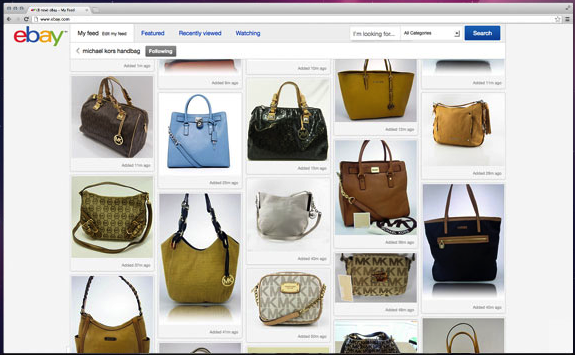You are viewing our site as an Agent, Switch Your View:
Agent | Broker Reset Filters to Default Back to ListPinterest Inspires Ebay; Why Not Real Estate?
November 06 2012
 Ebay will roll out its new Pinterest-styled homepage soon, featuring a picture-oriented experience. Makes us wonder why more e-commerce sites aren't doing the same?
Ebay will roll out its new Pinterest-styled homepage soon, featuring a picture-oriented experience. Makes us wonder why more e-commerce sites aren't doing the same?
Everything about niche-social networking site Pinterest is a marketer's dream. With only 20 million or so users, it might not be the largest network, but we could argue the audience is perhaps more valuable: 80% of the users are women, 55% of whom use an iPad to spend almost 16 minutes each on the site (1.9 billion times a month). As for the spending that really matters, one third of Pinterest users have clicked through and purchased a product they saw in the network, at an average of $180 per purchase. That's double the spending per person of Twitter or Facebook users.
So Pinterest is to Farmville what CocaCola is to the neighborhood lemonade stand.
Now mega-selling site Ebay has turned to Pinterest for its upcoming make-over. Sneak peeks of Ebay's refreshed homepage will be so Pinterest-like, we expect to hear M&A talks soon. Combining picture shopping and auction-selling should propel Ebay back into the attention spans of users who've become Facebook'd to death.
Which begs the question: Why haven't other industries copied Pinterest? Any ecommerce site could benefit from the picture-meets-purchase nexus: Automobiles, travel and real estate are perfect matches. Their customers shop by desire. They even disregard original price restrictions if provided with proper visual cues. How fun and compelling would it be to browse a travel site arranged by beach fronts, casinos or spa images, then clicked when you saw something you liked to reserve it? Shop by desired experience. You might even spend more than you intended.
Home buyers would be delighted to browse inventory by pictures of desirable features. Forget price, beds and baths--show a scrolling picture-set of living rooms, kitchens or pools in inventory to draw them in. Sellers could leverage one particular feature of their home to attract buyers who might have missed it if they'd searched only by mundane price or bedroom specifications.
While travel, auto and real estate sites have made progress adding more and better visuals lately, the pace remains painful. One look at Realtor.com, Zillow or Trulia and you'd be forgiven for thinking the stark Google homepage looked sexy. Most e-commerce site design remains dominated by database thinking. Consumers are stuck with search boxes, drop-downs, filters and sortable results. Long lists and multiple pages. Like an automated Sears catalog. An entirely un-human experience driven by computer engineering, not sales techniques.
When was the last time you walked into a Nordstrom's and performed a mental search-filter-sort-query before browsing through the shoes?
Pinterest has reminded marketers of the power of casual browsing. It has changed the model of online shopping, dramatically for the better. Everyone who has ever gone to the mall for "just one thing" and came out with bags of stuff they didn't know they needed understands what Pinterest has done for e-commerce. Now it's up to other sites to take the hint and simply copy the model. Thanks, Pinterest, for reminding marketers that databases are for computers; but pictures are for purchasers.
To view the original article, visit Matthew Ferrara's blog.









